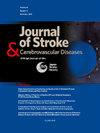Seven years of CRAFT: Clinical results of a multicenter cohort of carotid artery relining with the CASPER RX stent
IF 2
4区 医学
Q3 NEUROSCIENCES
Journal of Stroke & Cerebrovascular Diseases
Pub Date : 2025-03-03
DOI:10.1016/j.jstrokecerebrovasdis.2025.108271
引用次数: 0
Abstract
Background and Purpose
Carotid artery stenting (CAS) is an established treatment for carotid stenosis or occlusion. Use of the dual-layer microporous CASPER RX stent has had mixed results in prior reports. The CaRotid Artery Filtering Technique (CRAFT) uses the distal end of the CASPER stent as an embolic protection device during deployment. We present the largest cohort of patients having undergone CAS with the CASPER stent and report our multicentre experience with CRAFT over the last seven years.
Materials and Methods
All patients undergoing CAS at three tertiary neurointerventional centres in Australia from April 2016 to April 2023 were included. Patient demographic, procedural and clinical data were retrospectively collected. All included patients underwent CAS with CASPER stent insertion using CRAFT.
Results
215 patients (74 % male, mean age 70) were included in the study. Most patients (89 %) were treated on an emergent basis with 81 % of these representing tandem lesions in acute ischaemic stroke. Median NIHSS score was 12 on admission and 6 post-procedure. 98 % achieved an mTICI score of 2b or higher. Median mRS score was 1 at the time of earliest outpatient follow-up. 90 % of patients received intraprocedural antiplatelet therapy. 10 % suffered symptomatic intracranial haemorrhage and 7 % had stent occlusion. An 8 % all-cause mortality rate was observed.
Conclusion
Emergent CAS with the CASPER RX stent and CRAFT is both safe and efficacious, with low rates of stent occlusion and restenosis as well as a low risk of major complication. Given the limited sample of elective patients in our cohort, further studies are required to corroborate the safety profile of CRAFT in elective CAS
7年的CRAFT:一项多中心队列颈动脉再灌注CASPER RX支架的临床结果。
背景和目的:颈动脉支架植入术(CAS)是治疗颈动脉狭窄或闭塞的常用方法。使用双层微孔CASPER RX支架在先前的报道中有不同的结果。颈动脉过滤技术(CRAFT)在部署期间使用CASPER支架的远端作为栓塞保护装置。我们呈报了接受CASPER支架的CAS患者的最大队列,并报告了我们在过去七年中多中心CRAFT的经验。材料和方法:纳入2016年4月至2023年4月在澳大利亚三家三级神经介入中心接受CAS治疗的所有患者。回顾性收集患者人口学、程序和临床资料。所有纳入的患者均行CAS并使用CRAFT植入CASPER支架。结果:215例患者(男性74%,平均年龄70岁)纳入研究。大多数患者(89%)在紧急情况下接受治疗,其中81%的患者代表急性缺血性卒中的串联病变。入院时NIHSS评分中位数为12分,手术后为6分。98%的学生获得了2b或更高的mTICI分数。最早门诊随访时mRS评分中位数为1分。90%的患者接受了术中抗血小板治疗。10%出现症状性颅内出血,7%出现支架闭塞。全因死亡率为8%。结论:CASPER RX支架与CRAFT联合应用急诊CAS安全有效,支架闭塞再狭窄发生率低,主要并发症发生风险低。考虑到我们队列中选择性患者的样本有限,需要进一步的研究来证实CRAFT在选择性CAS中的安全性。
本文章由计算机程序翻译,如有差异,请以英文原文为准。
求助全文
约1分钟内获得全文
求助全文
来源期刊

Journal of Stroke & Cerebrovascular Diseases
Medicine-Surgery
CiteScore
5.00
自引率
4.00%
发文量
583
审稿时长
62 days
期刊介绍:
The Journal of Stroke & Cerebrovascular Diseases publishes original papers on basic and clinical science related to the fields of stroke and cerebrovascular diseases. The Journal also features review articles, controversies, methods and technical notes, selected case reports and other original articles of special nature. Its editorial mission is to focus on prevention and repair of cerebrovascular disease. Clinical papers emphasize medical and surgical aspects of stroke, clinical trials and design, epidemiology, stroke care delivery systems and outcomes, imaging sciences and rehabilitation of stroke. The Journal will be of special interest to specialists involved in caring for patients with cerebrovascular disease, including neurologists, neurosurgeons and cardiologists.
 求助内容:
求助内容: 应助结果提醒方式:
应助结果提醒方式:


